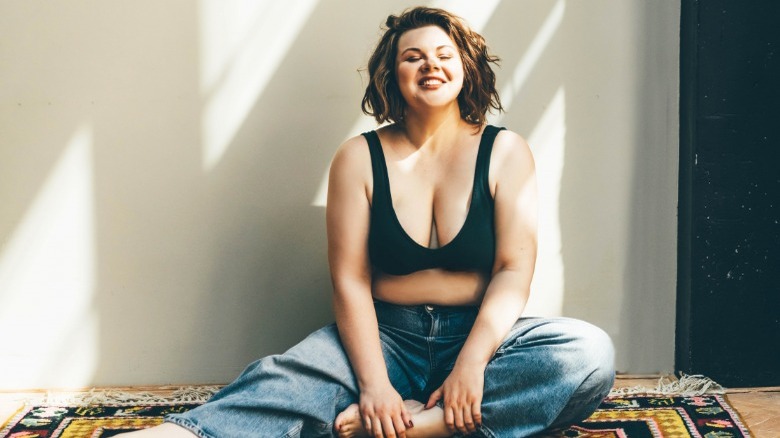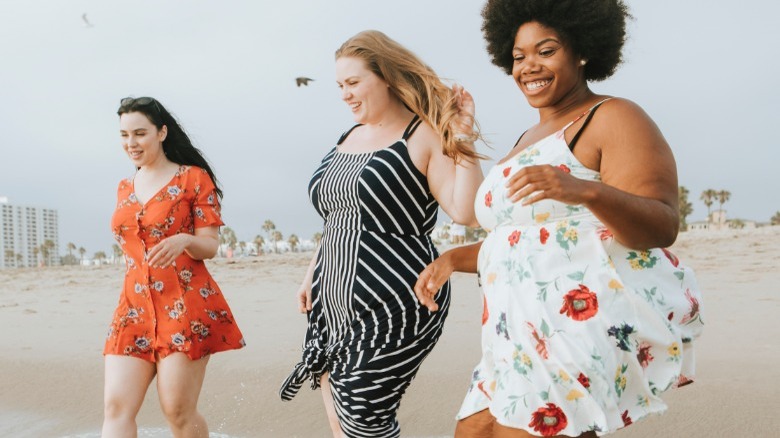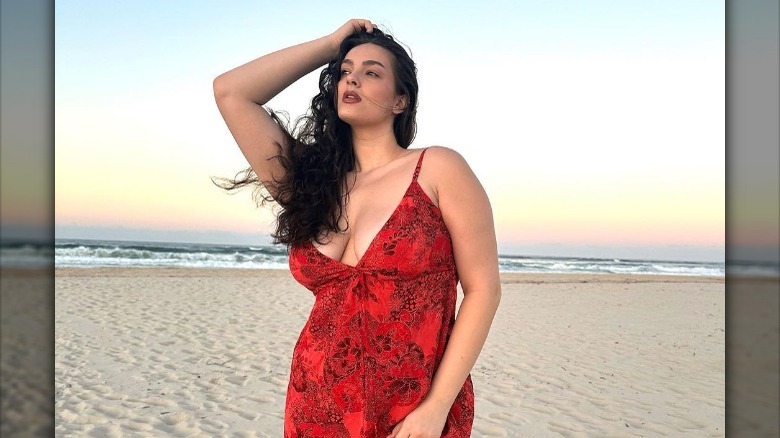The Mid-Size Debate: What The Term Means And Why It May Not Actually Be Empowering
Are you skinny, or are you fat? For people who wear seemingly in-between clothing sizes, this question can get complicated. No matter how much vocal support you give to the body positivity movement, there's still a tiny voice in the back of your head that craves the validation of a size label, whether that's being accepted into petite mainstream fashion or being uplifted by the fat liberation community.
For the folks occupying the not-skinny-but-not-fat space, a newer term has emerged: mid-size. The term has gained popularity in the last several years, and mid-size has become a prominent identifier for influencers. When you search the tag on social media, you'll be greeted by confident, attractive women with full figures and fantastic styles. But while the mid-size discourse has all the trappings of an inclusive, empowering movement, the idea feeds into an incredibly limited conception of how we think about our bodies.
What's mid-size?
Mid-size refers to a body size that is larger than women's straight sizes (sizes 0 through 8) but smaller than plus sizes (sizes over 16). If you spend a lot of time on the fashion side of the internet, you're likely already well-acquainted with the mid-size concept. The term popped up in 2018 with the launch of the MidSize Collective, a U.K.-based fashion movement. Since then, "mid-size" has become a go-to phrase for describing this traditionally undefined size range.
From a purely consumer perspective, the need for a mid-size movement is apparent. According to CDC statistics, the average adult woman in the United States is 5 feet, 3 inches tall and weighs 170 pounds. That translates to a lot of people wearing clothing sizes that are bigger than size 8. In 2016, researchers estimated that the average U.S. woman wears a size 16 or 18 (per the International Journal of Fashion Design, Technology, and Education). Simply put, most of the clothing sizes you see on the runway or in fashion photography don't match what the average consumer will actually be buying.
To fill this gap, mid-size influencers provide followers with content that suits their style needs, modeling outfits in more average clothing sizes and giving fashion tips that you wouldn't get from mainstream platforms.
The difference between fat and mid-size
The term mid-size can be useful for finding style ideas online, but the concept has a strained relationship with body positivity and fat liberation. Many mid-size influencers don't use the word "fat" to describe themselves. In their desire to address an often-overlooked sizing group, influencers end up drawing a firm line between mid-size and fat. For some, this gives the impression that folks in the mid-size movement are uncomfortable being associated with fatness.
The obvious solution would be for mid-size influencers to start using the word "fat" and collaborating more with fat influencers, but there's another issue in play: Mid-size isn't fat. Whatever insecurities a mid-size person might have about their body, their experience is distinct from that of someone who is unambiguously labeled fat. When it comes to medical discrimination and social prejudices, there's a big difference between someone who wears size 10 clothing and someone who wears size 24.
This leaves the mid-size concept in an uncomfortable position. If influencers claim mid-size as a form of fatness, they run the risk of undermining the fat liberation movement and taking attention away from serious issues that affect people with large bodies. On the other hand, staying wholly unaffiliated with fatness can reinforce the kind of fatphobia that excludes plus-size folks from fashion in the first place.
The face of mid-size
The exclusive nature of mid-size doesn't stop at the issue of fatness. Within the mid-size community, there's a lot of angst over who gets to call themselves mid-size and which bodies are represented. If you search mid-size on TikTok or Instagram, most of the top results will be white femme cis women with hourglass figures. While this wasn't the intention when people started using the term mid-size, it's clear that this allegedly inclusive concept is dominated by the same normative beauty standards upheld by straight-size influencers.
There's also discomfort in the mid-size community with how many smaller-sized influencers are identifying as mid-size. Mid-size is usually defined as sizes 10 through 16, which is a relatively wide range. But as influencers with smaller bodies continue to disproportionately represent the mid-size community, they are becoming less welcome in some online spaces. For instance, popular TikToker Mary Skinner (who wears a size 10) recused herself from the mid-size label in a now-deleted video, explaining that she realized she was wrong to use the term after receiving negative feedback.
Although mid-size technically describes a type of clothing size, the term seems to have evolved to be determined more by perception and identity. If you're trying to be a mid-size influencer, it doesn't matter what clothing size you wear, only whether you match your audience's idea of what mid-size should look like.
Is mid-size redundant?
When you compare what mid-size claims to do versus what the term actually describes, it's less than liberatory, and it may even be redundant. The average U.S. woman wears a size 16, meaning that the majority of people who would fit into the mid-size range are smaller than average. While it's fair to say that people who wear sizes 10 to 16 are still underrepresented in the fashion industry and more inclusive sizing is needed, using mid-size as a body type identity seems to take for granted that those sizes belong in the middle, and it draws an unnecessary distinction between larger mid-size folks and those who wear the smaller end of plus-sizes.
There's an argument to be made that what gets called mid-size could actually be split into two categories. The lower end of the mid-size range would simply be the large side of straight sizes, while the upper end of mid-size is "small fat." Small fat is a term that appears in the fatness spectrum. As Ash Nischuk, the host of The Fat Lip podcast, explains to Ravishly, "Anyone who identifies as fat and is a size 18 or smaller is a small fat."
Using the term small fat in place of mid-size would both acknowledge the experiences of people with fat — but not properly plus-size — bodies and leave space for the smaller mid-size folks to still have their own community without accidentally undermining the fat liberation movement.
Clothing sizes are not body types
If you feel that you've heard way too much about specific clothing sizes in this debate, you're not wrong. The concept of mid-size lives and dies by clothing sizes — and once you unpack the arbitrary nature of clothing sizes, mid-size has very little use for empowerment.
Standardized clothing sizes really didn't begin until the 1940s. Prior to then, most people would sew clothes at home using patterns or get custom clothes based on their measurements. When the demand for ready-made clothing increased, the fashion retail industry had to develop a standardized sizing system. These sizing systems have evolved over the years, but the general problem remains the same: The sizes are only approximations, not precise measurements of a real person's body. Moreover, different brands use different sizing scales, so a size 14 at one store could be a 16 or 18 at another.
This is all to say that if you firmly define your body by the sizes you wear, you'll likely find that you have a very unstable conception of your appearance. Not only does your body change throughout your lifetime, but sizing systems will continue to vary as well. Mid-size can be a convenient shorthand for shopping, and even for requesting better sizing from companies, but true empowerment should be happening outside of the language of retail, or else you'll never escape the restrictive parameters of the fashion industry.





